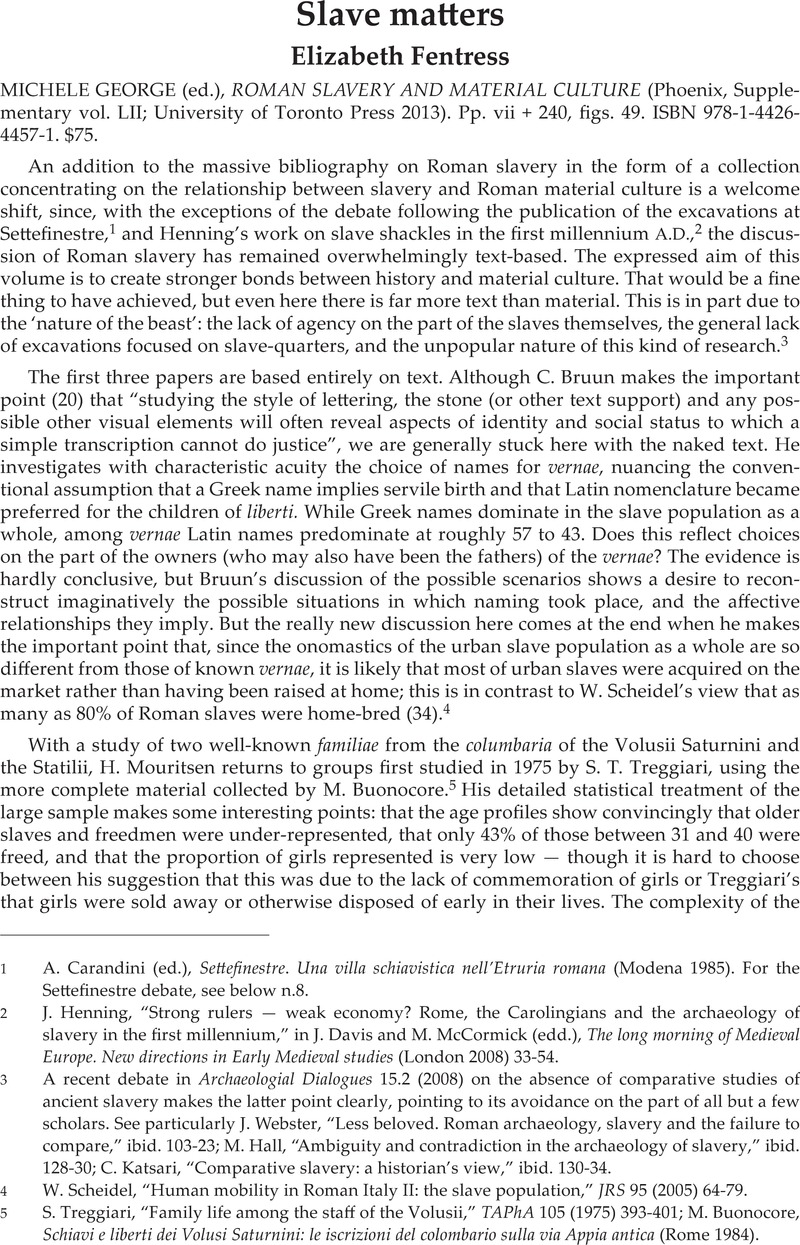No CrossRef data available.
Article contents
Slave matters - MICHELE GEORGE (ed.), ROMAN SLAVERY AND MATERIAL CULTURE (Phoenix, Supplementary vol. LII; University of Toronto Press 2013). Pp. vii + 240, figs. 49. ISBN 978-1-4426-4457-1. $75.
Published online by Cambridge University Press: 27 November 2014
Abstract

- Type
- Reviews
- Information
- Copyright
- Copyright © Journal of Roman Archaeology L.L.C. 2014
References
1 Carandini, A. (ed.), Settefinestre. Una villa schiavistica nell'Etruria romana (Modena 1985)Google Scholar. For the Settefinestre debate, see below n.8.
2 Henning, J., “Strong rulers — weak economy? Rome, the Carolingians and the archaeology of slavery in the first millennium,” in Davis, J. and McCormick, M. (edd.), The long morning of Medieval Europe. New directions in Early Medieval studies (London 2008) 33–54 Google Scholar.
3 A recent debate in Archaeologial Dialogues 15.2 (2008)Google Scholar on the absence of comparative studies of ancient slavery makes the latter point clearly, pointing to its avoidance on the part of all but a few scholars. See particularly J. Webster, “Less beloved. Roman archaeology, slavery and the failure to compare,” ibid. 103-23; M. Hall, “Ambiguity and contradiction in the archaeology of slavery,” ibid. 128-30; C. Katsari, “Comparative slavery: a historian’s view,” ibid. 130-34.
4 Scheidel, W., “Human mobility in Roman Italy II: the slave population,” JRS 95 (2005) 64–79 Google Scholar.
5 Treggiari, S., “Family life among the staff of the Volusii,” TAPhA 105 (1975) 393–401 Google Scholar; Buonocore, M., Schiavi e liberti dei Volusi Saturnini: le iscrizioni del colombario sulla via Appia antica (Rome 1984)Google Scholar.
6 The author does not seem to have been aware of D. Manacorda’s work on the inscriptions ( Un’officina lapidaria sulla via Appia [Rome 1979])Google Scholar, which dealt at length with their character as objects.
7 Camp, S. M. H., Closer to freedom: enslaved women and everyday resistance in the Plantation South (Chapel Hill, NC 2004)Google Scholar.
8 Marzano, A., Roman villas in central Italy: a social and economic study (Leiden 2007) 129–38CrossRefGoogle Scholar. One of the most curious of Marzano’s proposals is that slaves at Settefinestre were housed outside the main complex, in houses made of perishable materials like wood. I know of no buildings in Roman central Italy made of this material: almost all rural buildings, Settefinestre included, are indeed of perishable materials, specifically pisé de terre on stone foundations. The underlying assumption here, that “not necessarily for slaves” implies “not for slaves”, is logically unacceptable.
9 Principally Welwei, K.-W., Unfreie im antiken Kreigsdienst: III, Rom (Stuttgart 1988)Google Scholar.
10 Medri, M., “La ricostruzione delle casa,” in Carandini, A. and Papi, E. (edd.), Palatium e Sacra Via II. L’età tardo-repubblicana e la prima età imperiale (= BollArch 59-60 [1999]) 63–100 Google Scholar.




